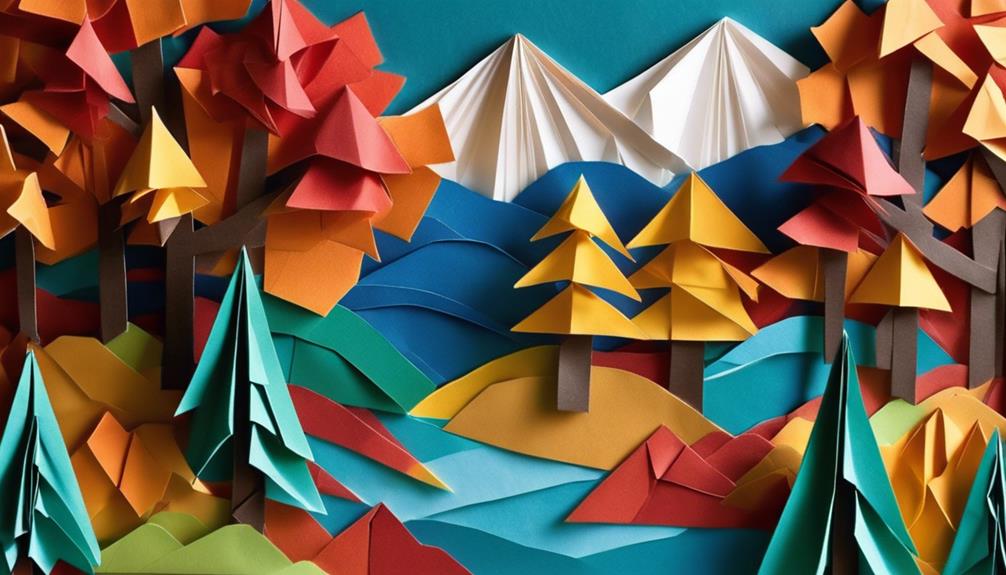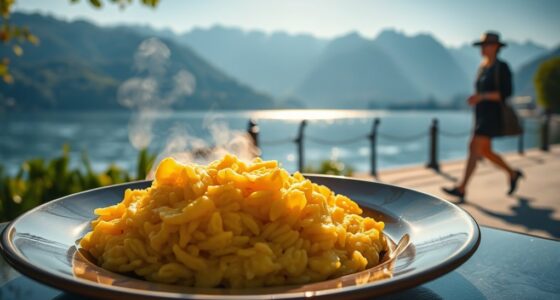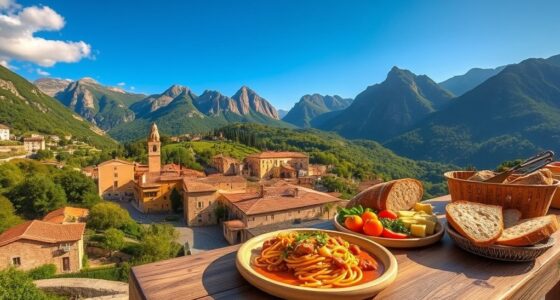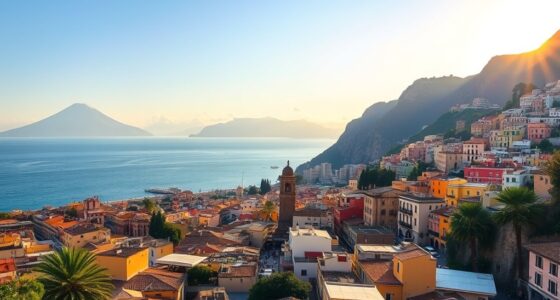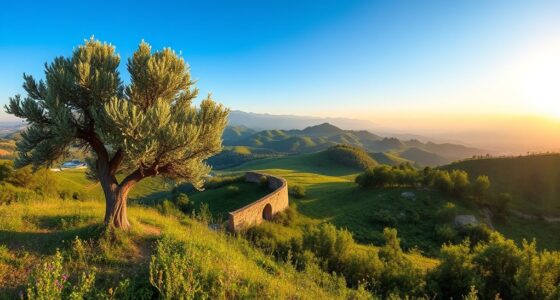Explore Milan's iconic cathedral, a Gothic masterpiece under construction for over 600 years. Marvel at its pinkish white marble and intricate carvings, housing the Madonnina statue atop. Immerse yourself in Milan's fashion culture generating billions annually, hosting luxurious events like Milan Fashion Week. Engage in the arts scene with global exhibitions and the vibrant Milan Design Week. Witness the fusion of tradition and innovation, where the Duomo stands as a symbol of Milan's timeless heritage. If you crave more insights into Milan's rich cultural tapestry, dive deeper into its fascinating journey of art, fashion, and architectural grandeur.
Key Takeaways
- Milan's iconic cathedral, the Duomo, harmonizes with the city's fashion and arts culture.
- Fashion capital Milan intertwines luxury brands and renowned designers with its Gothic masterpiece.
- Arts scene thrives with Milan Design Week, prestigious exhibitions, and La Scala Opera House performances.
- Fusion of tradition and innovation seen in Duomo's Gothic architecture and contemporary fashion trends.
- Milan embraces its cultural heritage through a blend of old-world charm and modern creativity.
Historical Evolution of Milan Cathedral
Starting its construction in 1386 under Gian Galeazzo Visconti's patronage, Milan Cathedral has a rich historical evolution that spans over six centuries.
The archbishop of Milan initiated the construction of the Cathedral, blending traditional Lombard styles with innovative Gothic elements.
The Cathedral of Milan, crafted with pinkish white marble from Candoglia, stands as a tribute to the city's architectural prowess and artistic heritage.
Over the years, various artists, sculptors, and citizens of Milan dedicated their skills to this monumental project, infusing it with a unique blend of creativity and craftsmanship.
Despite the prolonged construction period, the Cathedral's grandeur and intricate details have mesmerized visitors worldwide.
Recent restoration efforts led by the Veneranda Fabbrica have aimed to preserve the Cathedral's original splendor, ensuring that future generations can continue to marvel at its awe-inspiring beauty.
Milan Cathedral remains a shining example of Gothic architecture, with its statues on capitals and stunning stained glass windows captivating all who pass through its hallowed halls.
Architectural Marvels and Design Elements

The Architectural Marvels and Design Elements of Milan Cathedral showcase a blend of traditional Lombard styles and innovative Gothic features that have captivated visitors for centuries. The construction of the cathedral, known as the Duomo di Milano, spanned over six centuries, resulting in a Gothic masterpiece adorned with intricate carvings and statues on its façade, demonstrating unparalleled craftsmanship. The cathedral's location in Piazza del Duomo offers a stunning view of Milan's skyline from its rooftop, a highlight for many visitors.
One of the most striking features of the Milan Cathedral is its stained glass windows, which depict intricate biblical scenes, adding a colorful and spiritual dimension to the interior. Inside, visitors can admire the five naves separated by columns, creating a sense of grandeur and space.
Additionally, a unique Solar Sundial on the floor serves as both a clock and zodiac calendar, showcasing the innovative design elements incorporated into this architectural marvel.
Fashion Influence on Milan's Culture
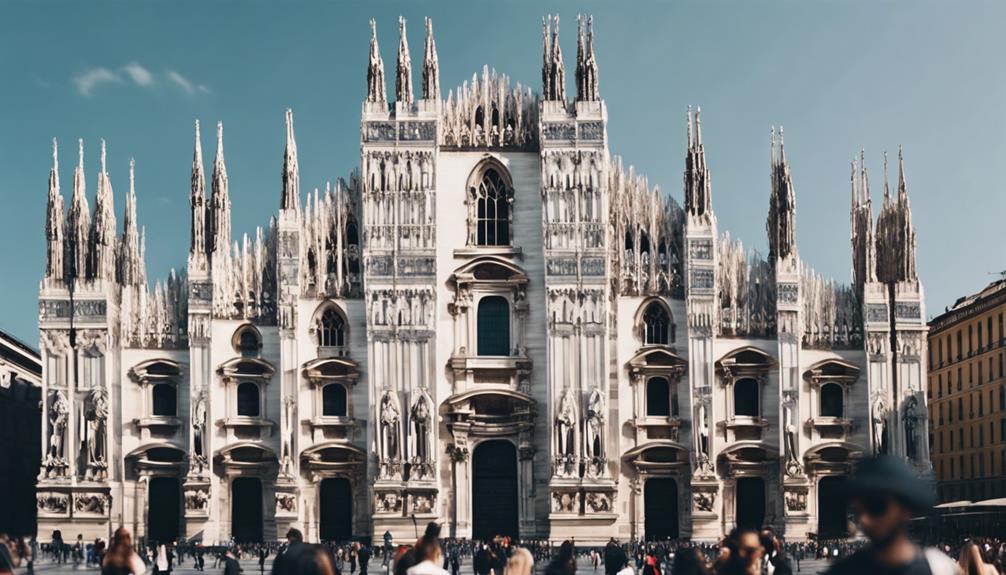
Fashion plays a pivotal role in shaping Milan's vibrant and dynamic cultural landscape, reflecting the city's rich heritage and contemporary flair. Milan, known globally as a fashion capital, intertwines its iconic Duomo cathedral with haute couture and luxury brands.
The city's fashion industry, which rakes in over 50 billion euros annually, not only boosts its economy but also solidifies its reputation as a trendsetter. Milan Fashion Week, a prestigious event showcasing the latest collections from renowned designers like Prada, Versace, and Gucci, draws fashion enthusiasts and industry insiders from around the world.
The Quadrilatero della Moda district stands as the epicenter of Milan's fashion scene, hosting flagship stores of top luxury brands. This fusion of history, art, and fashion creates a unique cultural tapestry that defines Milan as a hub of innovation and style.
The influence of fashion on Milan's culture is undeniable, permeating through its streets, events, and collective identity.
Arts Scene and Creative Events
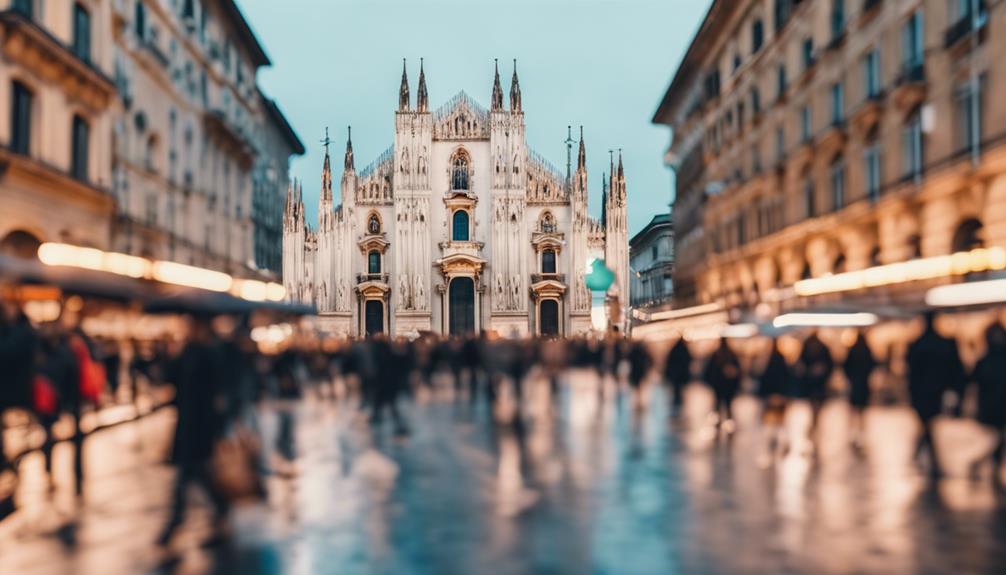
Milan's arts scene is a vibrant tapestry woven with events like Milan Design Week and Salone del Mobile, attracting a global audience.
Prestigious art exhibitions at venues such as Palazzo Reale and Museo del Novecento showcase the city's rich cultural heritage.
During events like Fashion Week, Fuorisalone, and Art Week, Milan's creative energy surges, welcoming artists, designers, and art enthusiasts from around the world.
Creative Events in Milan
With over 1,500 cultural events annually, Milan's arts scene is vibrant and diverse. The city pulsates with creativity, offering a plethora of opportunities to immerse yourself in artistic expressions. Milan Design Week, held in April, stands out as the world's largest design event, showcasing cutting-edge innovations in the design industry. La Scala Opera House sets the stage for around 280 performances each year, enchanting audiences with world-class operatic productions. Moreover, Milan Fashion Week is a biannual extravaganza featuring over 170 fashion shows, setting trends and shaping the future of fashion.
—
| Upcoming Creative Events in Milan | Date |
|---|---|
| Milan Design Week | April |
| La Scala Opera Performances | Year-round |
| Milan Fashion Week | Biannually |
| Artigiano in Fiera | December |
| International Photography Festival | November |
Arts Scene Highlights
The arts scene in Milan showcases a dynamic blend of traditional and contemporary expressions, drawing in a global audience of creatives and enthusiasts. When exploring the cultural landscape of Milan, there are several highlights that you shouldn't miss:
- Pinacoteca di Brera: This renowned art gallery houses an impressive collection of Italian Renaissance artworks, making it a must-visit for art lovers seeking classical masterpieces.
- The Last Supper: Leonardo da Vinci's iconic fresco located at Santa Maria delle Grazie is a pinnacle of artistic achievement. Booking tickets in advance is essential to admire this masterpiece up close.
- Contemporary Art Galleries: Milan's creative energy also thrives in its contemporary art scene, with galleries like Fondazione Prada offering a platform for cutting-edge artists to showcase their innovative works.
Exploring these galleries will give you a glimpse into the city's modern artistic pulse.
Fusion of Tradition and Innovation
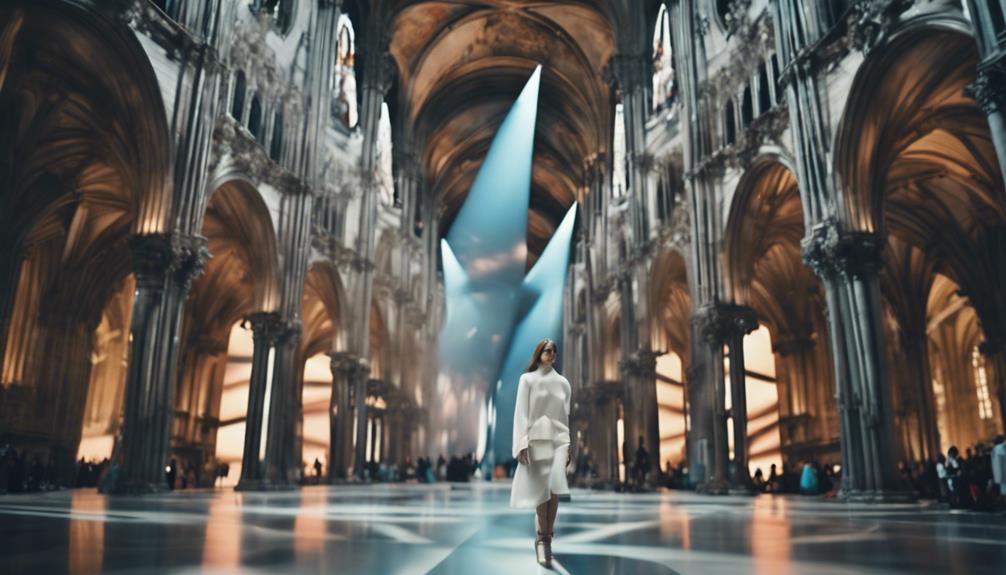
Blending tradition with innovation, Milan's cultural landscape captivates visitors with its dynamic fusion of heritage and modernity. The iconic Duomo, with its intricate marble facade and towering spires, serves as a validation of Milan's rich history while also embracing architectural advancements. The Duomo's stunning stained-glass windows, illuminated by natural light, beautifully harmonize tradition with contemporary design elements.
In the fashionable district of Brera, Milan showcases its innovative designs through the Quadrilatero della Moda. This area epitomizes the city's ability to blend traditional craftsmanship with cutting-edge fashion trends, attracting style-conscious individuals from around the world.
Even amidst the hustle and bustle of a construction site, Milan manages to preserve its cultural roots by integrating modern structures with historical landmarks. This juxtaposition creates a unique visual experience, where the old and the new coexist harmoniously, reflecting Milan's dedication to honoring its past while embracing the future.
Impact of Duomo on Milan's Identity

Milan's identity is deeply intertwined with the profound impact of the Duomo di Milano, a towering Gothic masterpiece that symbolizes the city's resilience and pride.
The construction of the Duomo spanned over six centuries, commencing in 1386 under the patronage of Gian Galeazzo Visconti, showcasing the enduring commitment of Milan to this architectural marvel.
The Duomo's striking facade, crafted from exquisite white marble, not only serves as a validation of the city's rich history but also as a beacon of artistic and cultural significance.
- The Duomo's construction under Gian Galeazzo Visconti over six centuries highlights Milan's dedication to preserving its heritage.
- The intricate design and grandeur of the white marble facade symbolize Milan's artistic prowess and attention to detail.
- The Duomo stands as a demonstration of Milan's resilience and pride, attracting visitors from around the world to admire its beauty and historical significance.
Frequently Asked Questions
What Is the Milan Cathedral Known For?
The Milan Cathedral, or Duomo di Milano, is renowned for its grandeur and intricate design. Boasting 3,400 statues, 135 gargoyles, and 700 figures, it stands as a stunning architectural masterpiece.
Additionally, the cathedral features a sundial that regulates the city's clocks. Constructed since 1386 with Condoglian marble, it's a symbol of rich history and craftsmanship.
The cathedral's historical relics, like the crucifixion nail, further add to its significance.
What Is Milan's Culture?
Milan's culture is a rich tapestry of modernity and tradition, blending historic sites with contemporary art and culinary delights. The city's diverse social scenes and artistic influence create a unique atmosphere.
From traditional trattorias to renowned opera venues, Milan offers a fusion of old and new that captivates visitors. The vibrant streets and cultural diversity reflect a city that cherishes its heritage while embracing innovation.
What Are the Gothic Elements of Milan Cathedral?
To understand the Gothic elements of Milan Cathedral, focus on its intricate architectural features like pointed arches, ribbed vaults, and flying buttresses. These elements create a sense of verticality and grandeur, typical of Gothic design.
Additionally, the cathedral's facade is adorned with over 3,400 statues, and its stained glass windows depict vibrant biblical scenes.
Inside, you'll find slender columns, detailed carvings, and a high central nave, all hallmarks of Gothic architecture.
Does Milan Cathedral Have a Dress Code?
Yes, Milan Cathedral does have a dress code to maintain a respectful atmosphere. It's recommended to dress modestly, covering your shoulders and knees.
Sleeveless tops, shorts, and short skirts are generally not allowed inside the cathedral. Respecting these guidelines guarantees a smooth visit and shows consideration for the sacred space and worshippers.
Remember to adhere to the dress code for a respectful experience at Milan Cathedral.
Conclusion
In Milan, marvel at the majestic Duomo, immerse yourself in a world of fashion, and indulge in the vibrant arts scene.
The fusion of tradition and innovation creates a unique identity for this iconic city. Experience the beauty and creativity that define Milan's culture, where history, design, and style converge in perfect harmony.
Milan's cathedral, fashion, and arts culture are truly a sight to behold, enriching the city's spirit and enchanting visitors from around the world.


